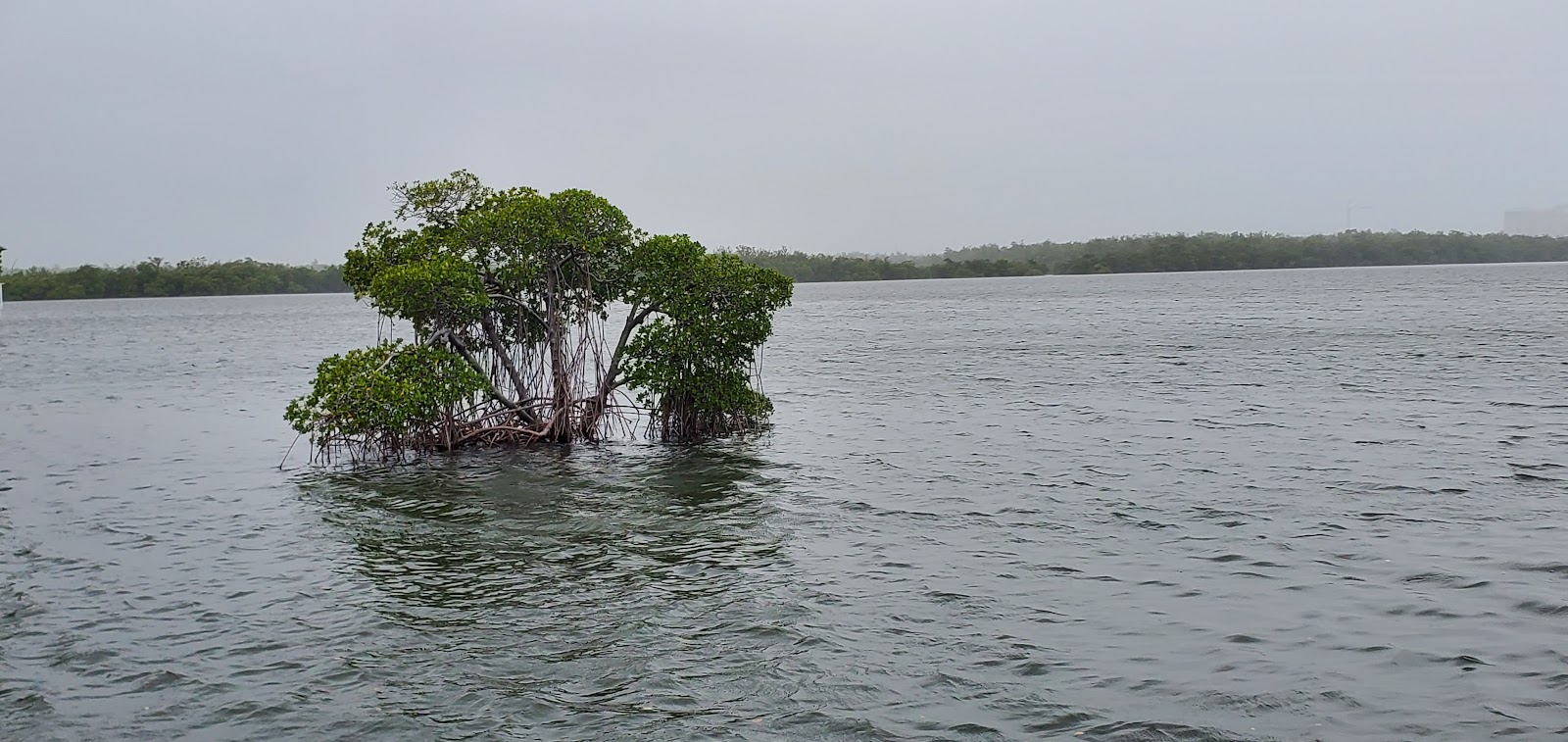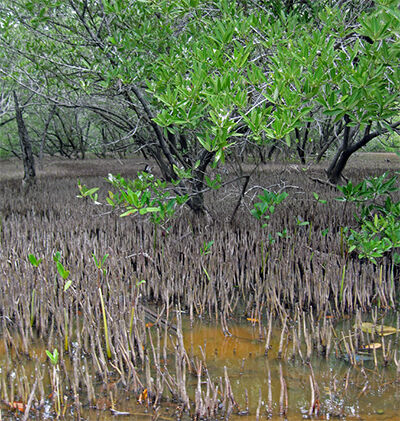Discovering Florida's Mangroves: A Closer Look at the Brown Pelican and More
 |
| Red Mangrove(Rhizophora mangle) |
However, don't worry; these roots are called prop roots and are in fact extremely sturdy, having evolved to specifically keep the tree standing upright. In huge hurricanes and thunderstorms, mangrove trees absorb most of the water's impact, as seen in this diagram from the Nature Conservancy:
Red Mangroves are some of the most easily distinguishable mangrove trees, due to their exposed, red-colored root structure. These prop roots can be up to 3 feet(1 meter) from the soil, and their purpose is to handle high/low tides and storm surges. Red Mangroves are located far into the coast, but most commonly located on the water's edge. Their prop roots provide a habitat for the Mangrove Tree Crab, which was in abundant numbers when I went to visit the Florida mangroves. There was a boardwalk running through the middle of the red mangrove habitat, and these crabs were everywhere. They were on the railings, they were on the boards, and they even popped out on an overhead tree branch occasionally.
Although all three mangroves intake saltwater, they have different methods of desalinating it. The Black Mangrove(and the White Mangrove, which I'll discuss next) both intake the saltwater through their roots, but then keep the water and excrete the salt through leaf glands. Red Mangroves filter out 90% of salt at the roots themselves. Black Mangroves are found a bit more inland than Red Mangroves, and White Mangroves are practically on land. Here is a chart showing each of their locations in regard to a coastline:
Without the mangroves' roots, floods would be a lot more devastating in Florida. Their expansive network of prop roots stops the flow of water from the ocean, also creating sediment deposits that enrich the soil and decrease erosion. Now let me discuss the three species of mangrove trees in detail.
Red Mangrove(Rhizophora mangle):
 |
| The sprawling Red Mangrove root system |
 |
| Mangrove Tree Crab(Aratus pisonii) |
These crabs are less than an inch in length, but they play a vital role in the mangrove ecosystem. They act as decomposers, breaking down plant and animal matter, and by munching on mangrove tree leaves, they help keep the soil free from leaf debris. While Red Mangrove trees harbor various species of wildlife, Black Mangroves have one of the most unique ways of getting oxygen to their roots.
Black Mangrove(Avicennia germinans):
Black Mangroves are also known for their unique root structures, like Red Mangroves. Black Mangroves have brown finger-like projections around the base of the tree, called pneumatophores(new - mat - o - fours) which provide oxygen to the tree's roots. In the case that the soil a Black Mangrove is growing on has little oxygen, pneumatophores come into play and provide fresh oxygen from the air itself.
Although all three mangroves intake saltwater, they have different methods of desalinating it. The Black Mangrove(and the White Mangrove, which I'll discuss next) both intake the saltwater through their roots, but then keep the water and excrete the salt through leaf glands. Red Mangroves filter out 90% of salt at the roots themselves. Black Mangroves are found a bit more inland than Red Mangroves, and White Mangroves are practically on land. Here is a chart showing each of their locations in regard to a coastline:
White Mangrove(Laguncularia racemosa):
White Mangroves are the only mangrove tree to have no exposed root system. They are located on dry, solid ground, and act as a sort of last resort against hurricanes and floods. Although White Mangroves look the most like a normal tree, they can still develop pneumatophores, also called peg roots, if the soil doesn't have that much oxygen.
White Mangroves are the least cold-tolerant out of all the mangroves. While this mangrove tree excretes salt through its leaves, it surprisingly also excretes sugar as well! Sugar-secreting glands, called nectaries, are located at the base of the leaves, and their purpose is to attract beneficial insects such as ants, deterring harmful pests away. White Mangroves also have multiple medicinal properties, such as their ability to heal wounds and treat fevers and tumors. This is due to their high concentration of tannin, a brown bitter-tasting chemical present in tree bark.
Mangrove Wildlife:
As you have probably already noticed while reading this blog post, the mangrove ecosystem is one of the most diverse and unique in the entire world. The mangroves are home to multiple endangered and irregular wildlife species. Let me describe to you some birds that reside in this habitat. Firstly, the Brown Pelican. This bird heavily depends on Red and Black Mangrove trees for nesting sites, since the habitat is one of the closest to its major food source: fish. Brown Pelicans congregate on mangrove islands and nest together in groups called rookeries, along with other beautiful birds such as Roseate Spoonbills, Magnificent Frigatebirds, Green Herons, and Great Egrets. While Brown Pelicans and other birds consider the mangroves to be their home, other wildlife such as the American Crocodile and the West Indian Manatee reside there, too. The American Crocodile depends on mangroves for food sources, and on the other hand, Manatees use the tight and secure network environment of the Red Mangroves to find food and raise young. Yellow and Black Crowned Night Herons use the mangrove habitat too, by preying on the Mangrove Tree Crabs. In fact, they ingest them so regularly and in large amounts that they're often nicknamed 'Crab-eaters'!
The mangrove ecosystem in Florida is one of the most diverse habitats in the entire world, and provides shelter to so many of the USA's most beautiful birds. Go visit the Florida Mangroves—who knows—you may spot a bird you've never seen before over there.






Comments
Post a Comment